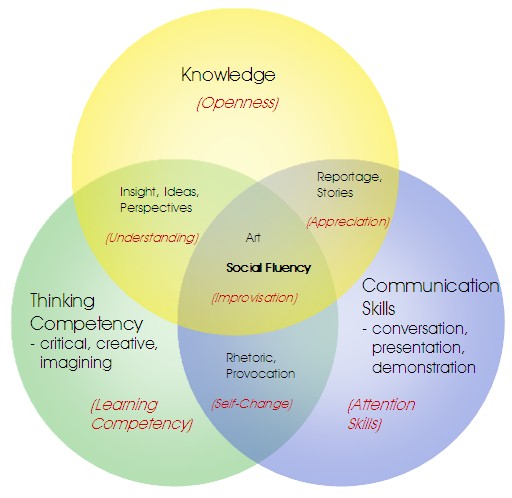
Social Fluency map, adapted from the work of Chris Lott. A brief explanation:
- The attributes in black depict those needed for social activity. Our social value to others is a function of (a) the extent of our knowledge, our thinking competency (critical, creative and imaginative), and our communication skills (conversation, presentation and demonstration), plus (b) our ability to integrate these three things. This integrate-ability gives rise to insight, ideas and new perspectives (application of thinking competency to knowledge), reportage and stories (application of communication skills to knowledge), rhetoric and provocation (articulation of our thinking competency), and art (the expression of thinking competency applied to knowledge). Art, in its broadest sense is the re-presentation of reality. The ability to integrate is social fluency. If we represented different individuals’ social fluency graphically, those with high levels of fluency would have larger circles (more knowledge, greater thinking competency and communication skills) with greater overlap (better integration of these three things).
- The attributes in red depict the re-active ‘mirror’ set of attributes for social response-ability. Our ability to derive social value from others (to learn) is a function of (a) our openness to others’ knowledge and ideas, our learning competency, and our attention skills, plus (b) our ability to integrate these three things. This ability to integrate these three things gives rise to understanding (openness to new ideas and knowledge, and the learning competency to process it), appreciation (openness to new ideas and knowledge, and the attention skills to be aware of them), and self-change (attention skills to be aware of change opportunities, and the learning competency to be able to apply them). The reactive counterpart to art is improvisation. Social fluency requires not only the ability to integrate knowledge, thinking competency and communication skills as an ‘actor’, but the ability to integrate openness, learning competency and attention skills as a ‘reactor’, a learner. That’s precisely what improvisation is about.
—————————-
The 12-week MOOC on Connectivism is now over. I haven’t been posting about it over the past few of weeks, but I thought it would be worthwhile doing a recap. Here are my final thoughts:
- Fifteen years of working in Knowledge Management have taught me that neither classroom training nor its virtual equivalent is an effective way to learn for most people. We learn best:
- By doing, practicing, trying it out for ourselves
- By watching over experts’ shoulders, and asking them questions as we do
- By conversing, iteratively, exploring, inquiring, sharing knowledge and co-developing insights and ideas
- By listening to stories
- By re-presenting: summarizing, re-telling stories, and through art and visualization
- Because we all learn differently, at different rates, unschooling (self-directed learning), learning to learn, and learning how we learn are inherently more effective than institutionalized or standardized learning.
- To me, connection has value to the extent it enables us to learn more, in any of the five ways listed above. Good connectivity processes and tools can help us:
- Find the right people to learn from/with, and
- Connect with those people more quickly, simply and effectively.
Connectivism argues that knowledge is patterns of (neural, conceptual and social) connections, and that learning is ‘making new connections’. In that sense, the course leaders assert that knowledge is connection. When we learn, whether by practicing, observing, conversing, listening to stories, or re-presenting, we are ‘making connections’ — neural, conceptual and/or social.
But I would argue that we are doing more than just making connections when we learn. We are creating, ideating, exploring, imagining, discovering, and these attributes of learning are inseparable from the pattern-making, connecting attributes. As we learn, doing all these things, we are becoming someone different, not only in the structures of our brains and understandings and networks, but in our capacities and activities. Learning changes not only our patterns of connection, but who we are and what we do, and can do.
It’s been an interesting experiment, participating virtually with hundreds of people following, very loosely, a common curriculum and course of study and exploration. I’d like to thank George and Stephen and all the interviewees and participants. I’ve learned a lot, and made a lot of new “connections”.
|





